Please read the important information regarding these games at the bottom of the page.
The Split Brain Experiments - Help
Aim of the game
In this game you will perform a classic experiment and observe how a split brain patient reacts to different objects shown to him in different vision fields. (In the 1960s, there was no other cure for people who suffered from a special kind of epilepsy than surgically remove the connection, corpus callosum, between the right and left hemispheres in the brain. "Split-brain" is a term to describe the result.)
Your mission is to figure out the differences between the left and right hemispheres in the brain. If you succeed, your results will be published in "The Very Scientific Journal".

1.
Read the introducing pages - proceed by clicking on the arrows in the bottom righthand corner!
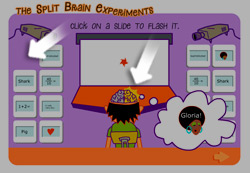
2.
The experiment is about that images shown in the left vision field (on the left side of the screen) is registered in the right hemisphere of the brain and vice versa. Can you figure out what differs in the reaction of Mr Split Brainy when the images are shown in the left and right vision fields? When is Mr Split Brainy able to read long words and perform maths? Which hemisphere is involved then?
Click on at least two images on each side before you proceed.
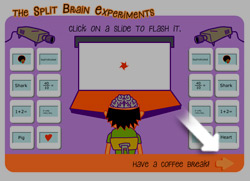
3.
Proceed by clicking on the arrow that says "Have a coffee break".

4.
Follow the discussion in the coffee room.

5.
To continue with your research you need more money. Click on the arrow "Get more money for your research".
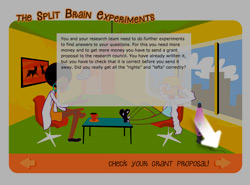
6.
You need to submit a grant proposal to the research council to gain extra funding. Click on the arrow "Check your grant proposal" to check your application before yousend it.
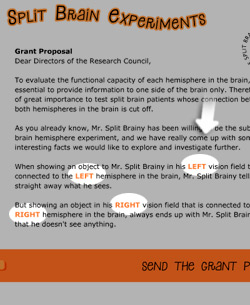
7.
Read the text in the grant proposal. You need to ensure that the words "left" and "right" highlighted in orange are correct. Click on the words to make corrections.
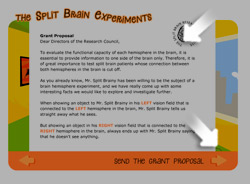
8.
When satisfied with the changes you have made, click on the arrow "Send the grant proposal".
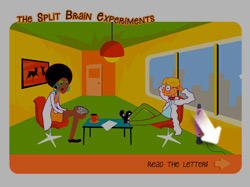
9.
Click on the arrow "Read the letter" to find out whether your grant application was successful.
If you are asked to revise your proposal go back and correct the orange-coloured words "left" and "right", and send the grant proposal again.
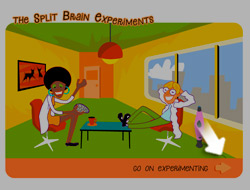
10.
If your grant application was successful you can proceed proceed by clicking on the arrow "Go on experimenting".
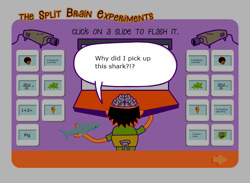
11.
This is a similar experiment to before (point 2), except that this time Mr Split Brainy is asked to pick up the objects he sees on the screen. Click on slides on both sides of the screen, and make a note of when Mr Split Brainy says "Why did I pick up this thing?" Is it after picking up objects shown in the left or the right vision field?
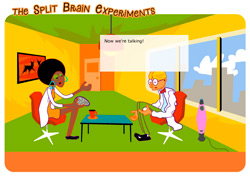
12.
Follow the conversation in the coffee room. It concludes that one of Mr Split Brainy's brain hemispheres is dumb. Which one do you think?
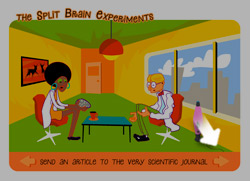
13.
Click on the arrow "Send an article to the very scientific journal".
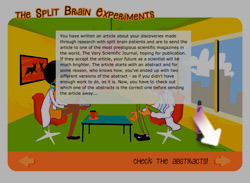
14.
Click on the arrow "Check abstracts".
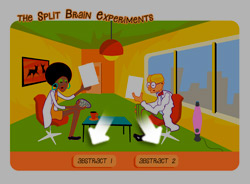
15.
Read abstracts 1 and 2 - which one is the correct one? Send the correct abstract by clicking on "Send this abstract with the article".
(An abstract is a short summary of a research article.)
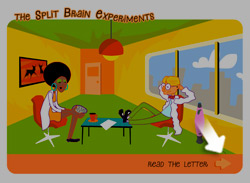
16.
Click on "Read the letter" to find out weather your article will be published in the journal or not.
Copyright © Nobel Media AB 2018
MLA style: "The Split Brain Experiments - Credits". Nobelprize.org. Nobel Prize Outreach AB 2022. <http://nobel-external-educationalgames-app.azurewebsites.net/educational/medicine/split-brain/help.php>
About the educational games
The educational games are based on Nobel Prize awarded achievements and were produced between 2001 and 2012. Most games have not been updated since production (including potential scientific facts changes) and are provided here on an 'as is' basis by popular demand.
Some of the games run in modern browsers without the need of any plugin (either as a new version or using Ruffle), but many of the games still require Adobe Flash Player. Flash is an old technology that has reached end of life. These games will no longer work without a dedicated setup. If you are depending on these games in your profession, please advice your local IT support. We do not have the resources to provide support.
We are working on supporting more games without Flash.